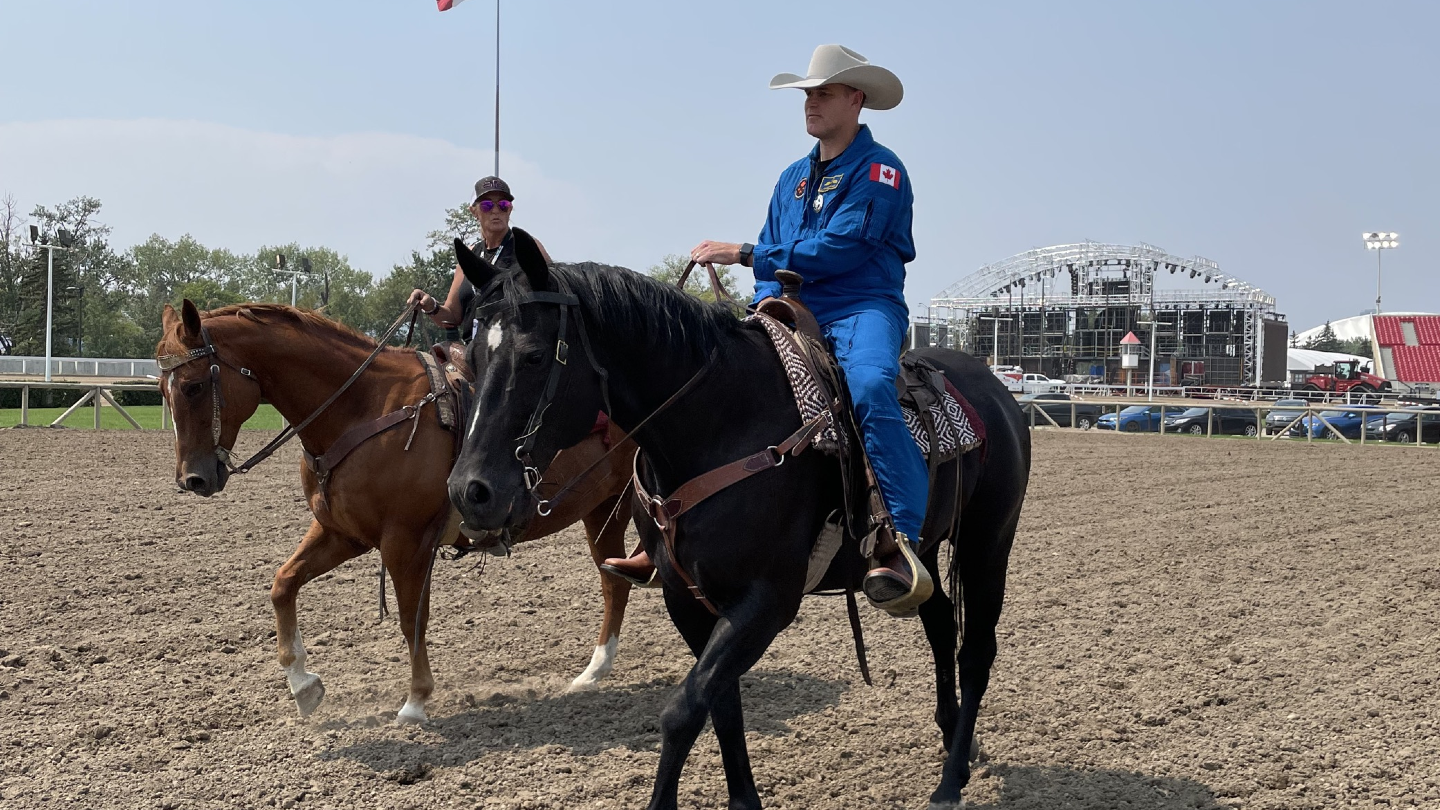
Thinking riding rockets is a challenge? Try a horse.
Canadian Artemis 2 moon astronaut Jeremy Hansen, partnering with his borrowed horse Cisco, pretended to be a cowboy at Canada's Calgary Stampede fair last week in the western province of Alberta. NASA Administrator Bill Nelson, who flew on the space shuttle Columbia in 1986 while a member of the U.S. House of Representatives, also visited the event.
"Thrilled to be at the Calgary Stampede, celebrating the spirit of exploration and adventure," Nelson wrote in a tweet on Saturday (July 8) showing him and Jeremy Hansen standing together in flight suits and adorned with cowboy hats. The two came together to "embrace the pioneering nature of space travel," he added.
Hansen was named to the Artemis 2 moon mission in April to honor Canada's commitment to contribute the robotic Canadarm3 to NASA's future Gateway space station. Artemis 2 will launch on its round-the-moon mission no earlier than November 2024. Hansen will be joined by three NASA astronauts on the flight, which will make the him the first non-American ever to leave Earth orbit.
Related: Artemis 2's Canadian astronaut got their moon mission seat with 'potato salad'
Hansen, who has limited experience with horses, practiced with Cisco before riding through the streets of Calgary as parade marshal for the Calgary Stampede. Versions of the stampede have run since 1886, celebrating cowboy culture and community. Today it attracts more than a million attendees annually during a week of events in July.
I opened the @calgarystampede parade this morning. Thank you to everyone involved in this event and for your trust as I took on this meaningful role. pic.twitter.com/FcKINQF6guJuly 7, 2023
This may be my first @calgarystampede, but not for my trusty ride Cisco!Cisco has been in numerous Stampede parades, and he was an absolute pleasure to ride yesterday. Looking forward to today! pic.twitter.com/gsTblQcJoMJuly 7, 2023
I’m grateful for the way that Stampede-goers and the #USConsulate welcomed our important @nasa partners on the #Artemis mission. I was also proud to see how much respect @SenBillNelson had for the #CalgaryStampede, and this wasn’t his first rodeo. Oh Canada! 🇨🇦 pic.twitter.com/h12e1yws9gJuly 11, 2023
Thrilled to be at the Calgary Stampede, celebrating the spirit of exploration and adventure! Joined my friend @Astro_Jeremy from @NASAArtemis to embrace the pioneering nature of space travel. Onward and upward! pic.twitter.com/vQQnSpf5l7July 8, 2023
Colonial expansion into the American and Canadian west uprooted, killed and marginalized Native Americans and Indigenous peoples, however, which the Stampede now seeks to recognize. Hansen, for example, also took time to visit Elbow River Camp, an Indigenous presentation of 26 tipis on the Stampede site (which are on unceded Indigenous territory).
Hansen has also worked regularly with Indigenous, Métis, Inuit and First Nations people of Canada for several years, most recently taking part in a vision quest this spring at Turtle Lodge in Manitoba on the lands of the Sagkeeng First Nation (also known as Fort Alexander).
Related: Watch these One Sky Project films to explore Indigenous astronomy from home for free (videos)
NASA and Canada have been working as partners since the dawn of the space age. For example, a NASA rocket launched Alouette, the first Canadian satellite, in 1962. The Canadarm robotic arm for NASA's space shuttle allowed Canadians to begin flying in space in 1984, while Canadarm2 opened the door for International Space Station (ISS) assignments.
Canadians have also played key roles as NASA contractors and employees for decades. Engineers from a canceled Canadian jet program, the Avro Arrow, contributed to early spaceflight programs at NASA starting in 1959 (including the Apollo moon landings).
Canadian "legs" from the company Devtek (today's Héroux-Devtek) flew aboard the Apollo moon landers between 1968 and 1972, and dual U.S.-Canadian NASA astronaut Andrew Feustel commanded the ISS in 2018, among other milestones.







